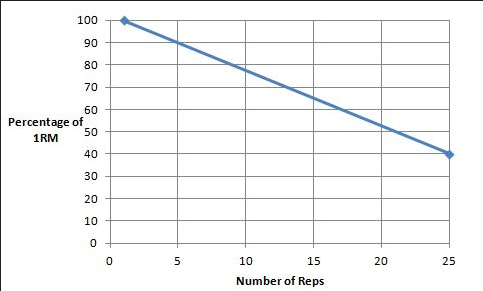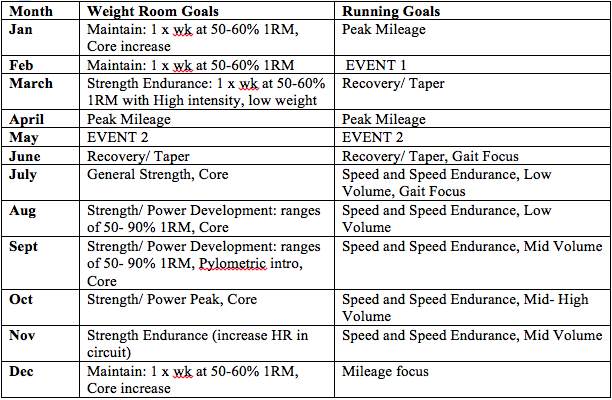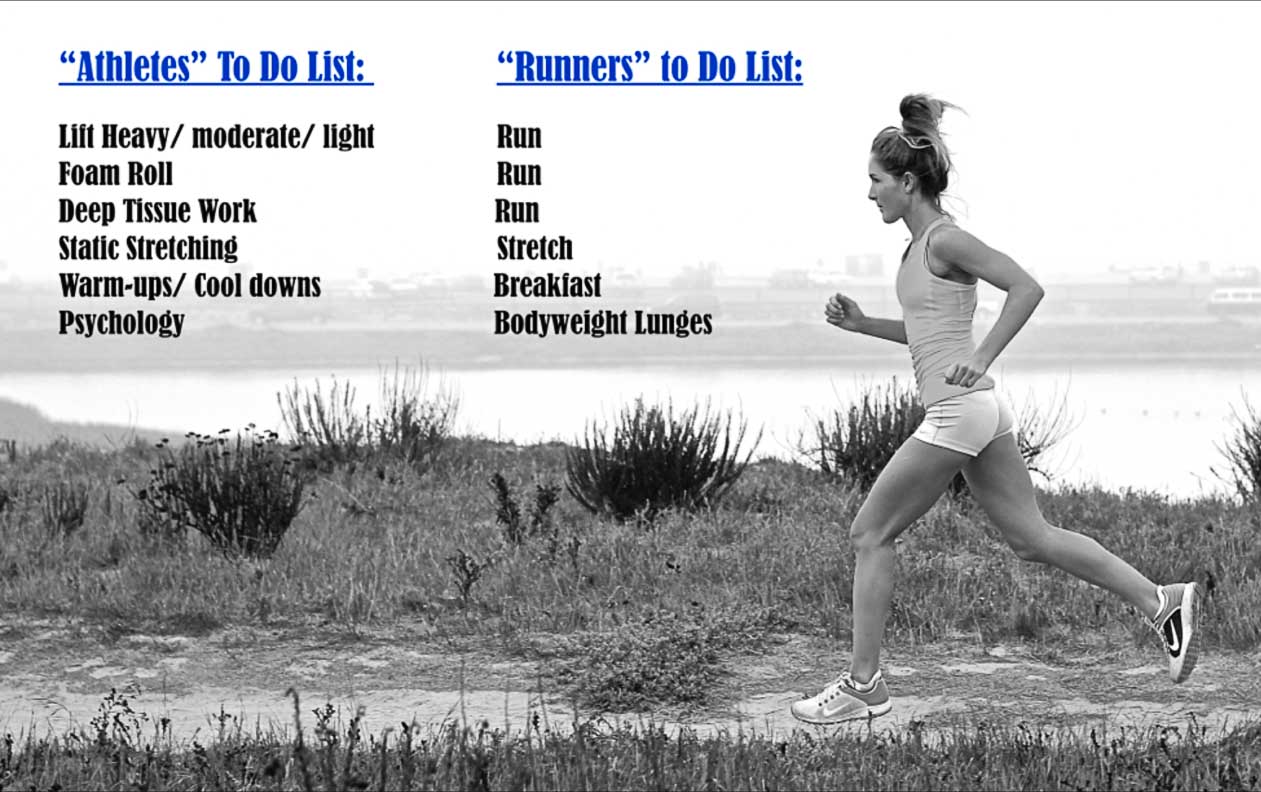Resistance Training for Runners
Resistance Training for Runners
Before I start if you find any typos please let me know on our contact form… I HATE proof reading but love putting out content.
So if you want to help me out… thanks in advance and I hope you get some insight on resistance training for athletes from the article.
Resistance training for runners comes in a few forms:
- Machine-based
- Single Joint approach
- Complex Motion approach
- Functional Movement approach
In this article I don’t want to spend time on the different types of resistance training for runners but more so what type of load or resistance is needed to make a difference in your sporting career (high school, college or even weekend warrior).
On a clinical level, I deal with many musculoskeletal injuries, which are injuries to muscle, tendon, ligament, cartilage or bone.
I find many athletes have an issue understanding is how much resistance training is enough for them to sustain their sports.
By “sustaining” I am talking about the amount of resistance training needed to keep them relatively “overuse injury free” and playing with the intensity they desire.
NOTE: There are more parts to preventing overuse injuries but this article is on resistance training for runners. Other parts are movement patterns, endurance to hold proper form and proper joint mobilization.
I personally still play in a men’s baseball league and I have said over and over again I will quit when I am not happy with my level of play. To keep that level I need to be free of injury and strong to throw, hit and sprint.
If I cannot play at my reckless level then I will hang up my cleats.
Old sayings never die
Grandma use to say “if you don’t use it you lose it”…. She was correct.
She did’t need a masters to hit the nail on the head. Muscles,tendons, ligaments and bones don’t continue to keep the same integrity, size and strength if your activity level does not require it.
Here are a few concepts we use in the medical and training field with the topic of resistance training for athletes:
- Wolff’s Law
- SAID Principle

Wolff’s Law for Resistance Training for Runners
Wolff’s Law applies to bone density and architecture.
Anyone whom has been told they have osteopenia or osteoporosis should have been instructed to follow this law.
When your doctor told you to start doing “body weight exercise” or “resistance training” this is the theory they are following.
Sure they may have also told you to take some supplements or pills as well but the loads in resistance training tell your body what to do with the new materials.
Building muscle and bone is not a passive process, it is dependent on if you lift or not.
Forces placed upon the bones and joints require the body to reinforce the area with new bony architecture called trabecular bone.
If you search the Internet for images of “Osteoporosis of the femoral head” you will see what I am talking about. Without adding a resistance on the bones osteoporosis, bone loss and eventually fracture will happen.

SAID Principle with Resistance Training for Runners
The Wolff’s Law for soft tissues is known as the SAID Principle or “Specific Adaptation to Implied Demand.” Muscles, tendons, and ligaments are known as soft tissues.
Do endurance athletes need to resistance train?
As an endurance athlete you may be thinking, “Why do I need to develop muscle?”
Fair enough, this is a common misunderstanding with many athletes but it is especially misunderstood with endurance athletes, such as distance runners, cyclist, triathletes, and other athletes who continually move at a constant pace for over an hour.
The “build up to tear down” physiological answer in near impossible to discount.

Catabolic Process for energy usage: “A Breakdown”
A distance athletes much of your energy is being derived from fats and proteins after about 15-30 minutes of cardiovascular exercise (let’s not argue the exact time frame, that is a whole other article topic).
Carbohydrates are used as an energy source in the beginning of your event but as your time increase your energy sources start to blend.
This is called a catabolic process, or breakdown of tissue of the body for use as energy. The opposite is anabolic, which we will go into next.
Every time a distance athlete steps out the door for a multi-hour training session they are breaking their body down for energy.
Over a season of training each session will add up creating a drop in weight, strength, and joint stability. Keep in mind I am not talking about speed or performance, I am purely talking about body composition and injury prevention at this point.

Anabolic Process: “Building up before breaking down”
Resistance training, when done correctly, is an anabolic process. Anabolic is a building of soft tissue structure of the body; just think of anabolic steroids and body builders. They are an outlier or extreme versions of an anabolic process.
At this point in conversation people will say “I don’t want to get too big.”
If you have any hesitation to adding this type of training in I can assure you won’t.
Just like any other type of training, you need hours of hard work, dedication, good planning and proper nutrition to thrive.
Body builders often lift 2 times a day, take multiple naps a day (to increase Growth Hormone secretion), and eat very clean to make the muscular gains they do.
It doesn’t just happen and as someone who lifts 3+ times a week it’s amazing how much I do not look like one of them. Most distance athlete will not even dedicate more than an hour or so a week to resistance training and will not become too “bulky.”
If you do become too bulky (in less than 1 hour a week) please send me an email with before and after and I will post your picture as an outlier on this very article.

How much is enough weight is proper for resistance training for runners?
Let’s use a graph to help.

Notice on the vertical axis we have percentage of 1RM. 1RM is a “one rep max,” which means the weight is so heavy you can only lift it one time… no more no less.
On the horizontal axis is “number of repetitions” in a set.
Rules of Resistance Training for Runners from a Strength & Conditioning point of view
I like ranges of 50 – 90% 1 RM personally. This ranges has the lowest risk to reward ratio meaning it is very safe (in most cases with proper form) and have a very large return on your time spent. The most desired rewards are muscle and bone density gains for a very little amount of time spent at the gym.
With higher ranges there is a risk of injuries from poor form due to high load resulting in weightroom injuries such as muscle strain, tendon rupture, ligamentous sprain, disc injuries and more.
With resistance lower than 50% 1RM you are just wasting your time if your goal is anabolic gains.
Anything lower than 10% 1RM you might as well go out hiking or running since your repetitions will be well beyond 25. I often ask new clients how many reps (steps) are in their “resistance training” of hill running.
Answers range from 100 to 1000s… regardless this entire rep range is eventually below 10% 1RM and we may as well just call this cardio. Let’s not fool anyone.
Here’s an example of how to use the graph. It’s easiest if you have an estimation of what your 1 rep max is but there are also calculators on the Internet for that.
My 1 RM Front Squat is 220lb
50% 1RM is 110lb.
I should shoot for about 20 reps without stopping a ton, but around the higher rep numbers (16-20) I should feel as if I am being challenged.
Sound impossible? It really isn’t. My general estimation of what a beginner should be able to do according to gender is the below. These are very realistic expectations.
For Women:
• Deadlift 101% of your Ideal Body Weight
• Squat 75% of your Ideal Body Weight
• 15 Modified Push-ups (full depth) within a minute
• 1 Pull-up would be impressive within a minute but I would be ok with a 1 minute deadhang.
• 2 Minute Plank Hold (no wobbling)
• 30 seconds holding a Single Leg Bridge (no wobbling)
For Men:
• Deadlift 133% of your Ideal Body Weight
• Squat 101% of your Ideal Body Weight
• 15 Push-ups (full depth) within a minute
• 8 Pull-up would be impressive within a minute
• 2 Minute Plank Hold (no wobbling)
• 30 seconds holding a Single Leg Bridge (no wobbling)
Don’t want to add it to your program still?
That’s ok… it’s a personal choice but I almost always suggest these changes.
Remember majority of research and scientific articles support these theories and it’s hard to argue what research says to be true.
Note: I plan on doing an article on how correct movement patterns correlate to injuries, prevention and lifting as well. When it is live it will have this link live too.
As I word it to most of my clients, if they are coming to me for prevention or rehab on a “Musculoskeletal” condition (overuse of tendon, muscle, strain, sprain etc)…
Do not try to rehab a musculoskeletal injury with a cardiovascular activity.
And yes I would love you to quote me on that. 🙂
Simple as that…
Distance events are cardiovascular fitness with musculoskeletal stability requirements.
Yes quote me again!
Do not try to fix an Achilles Tendonitis with hill running, don’t try to fix it with cycling… just don’t do it. It’s against logic. We should be looking at movement patterns, trunk/ pelvis/ hip/ foot stability, total body strength and much more first.
Now as you are coming back from the Achilles tendon injury the miles you put in are for “testing purposes” and to get you back to your passion, not for rehab purposes.
We are testing your tissue tolerance to load as well. If you could not tolerate a mile of running before would it be reasonable to think without rehab and loading that it could tolerate it anymore now?
How to use anabolic to offset catabolism
Let’s use logic; you need to build something before you tear it down. Resistance training for athletes is exactly this.
Don’t have time for it while training during your season?
- Fair enough, but do you have 30 minutes a week?
- Do you watch TV?
- Do you meet for coffee?
- Do you have time for your mileage and other cardio cross training?
If you said yes to any of these you should sub out some social time or mileage to prevent your body from breaking down because if you have an injury then you will be free for coffee all the time. Although that’s not always a bad thing… for those of you who know me know I also roast coffee as a side passion. (check out Coffee Roaster Huntington Beach for more info)
In an ideal world here’s a very basic training program with addition of some resistance training for athletes.
It can be modified a bit based upon your personal goals but let it serve as a glimpse into what “should be.” Endurance training needs an off-season, just like football, baseball, track etc. but it needs to be a true off-season, unlike modern day youth athletic off-season.
Note: Youth off-seasons will be the central focal point for an article to come. It is a HUGE safety issue for our young athletes. They have continual seasons and early specialization in a sport. This is a recipe for soft tissue injury and bone issues, such as growth plate fractures and CAM deformities in the hip.
Here’s an example of a year of training for a marathoner with a 2-race goal for that year. From a clinical point of view I would target no more than 3 serious races a year, perhaps a month out from each other.

Again this is a template and can be modified severely but you should get the idea of what I wanted to show. You should be focusing on different anabolic and catabolic processes at different times in the year to keep healthy.
To recap the topic of Resistance Training for Runners
Every athlete from curlers to football players need resistance training, in addition to a few other things. Here’s the poster I have at my office… on the left is a well-rounded athlete, the right (I labeled as Runners… sorry guys!) represents those weekend warriors whom think they are special exceptions to current Strength & Conditioning and Sports Medicine theory.

Sorry guys, I believe in tough love and take this all in the light it was intended… I am here to help and not sugar coat it for you. If you want it all, work hard and educate yourself… you will be happy you did.
If you need further help we do offer one-on-one consulting via phone by appointment only… check out our HOME PAGE on the right upper portion section “Speak with our doc”… then you’ll get to speak with me personally!
Sebastian Gonzales III DC, CCSP®, CSCS, RMSK®
Performance Place® Sports Care
Huntington Beach CA 92647
Sports Injury Huntington Beach
714-502-4243
IG: @PerformanceHB
Youtube: search Performance Place
Want new articles before they get published?
Subscribe to our Awesome Newsletter.
